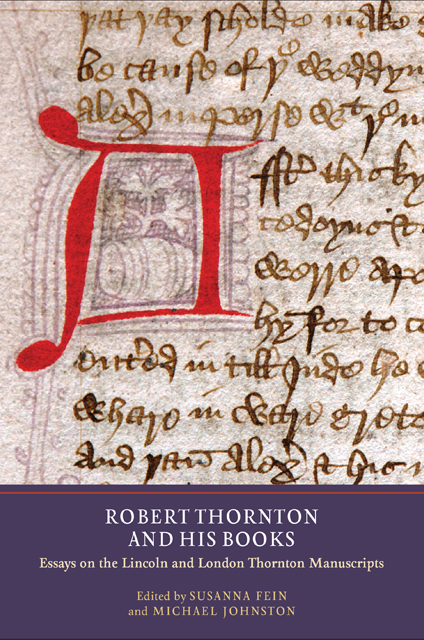Book contents
- Frontmatter
- Contents
- List of Illustrations
- List of Contributors
- Acknowledgements
- Abbreviations
- Introduction: The Cheese and the Worms and Robert Thornton
- 1 The Contents of Robert Thornton’s Manuscripts
- 2 Robert Thornton: Gentleman, Reader and Scribe
- 3 The Thornton Manuscripts and Book Production in York
- 4 The Text of the Alliterative Morte Arthure: A Prolegomenon for a Future Edition
- 5 ‘The rosselde spere to his herte rynnes’: Religious Violence in the Alliterative Morte Arthure and the Lincoln Thornton Manuscript
- 6 Constantinian Christianity in the London Thornton Manuscript: The Codicological and Linguistic Evidence of Thornton’s Intentions
- 7 Apocryphal Romance in the London Thornton Manuscript
- 8 Thornton’s Remedies and the Practices of Medical Reading
- Afterword: Robert Thornton Country
- Bibliography
- Index of Manuscripts Cited
- General Index
- York Medieval Press: Publications
Afterword: Robert Thornton Country
Published online by Cambridge University Press: 28 February 2023
- Frontmatter
- Contents
- List of Illustrations
- List of Contributors
- Acknowledgements
- Abbreviations
- Introduction: The Cheese and the Worms and Robert Thornton
- 1 The Contents of Robert Thornton’s Manuscripts
- 2 Robert Thornton: Gentleman, Reader and Scribe
- 3 The Thornton Manuscripts and Book Production in York
- 4 The Text of the Alliterative Morte Arthure: A Prolegomenon for a Future Edition
- 5 ‘The rosselde spere to his herte rynnes’: Religious Violence in the Alliterative Morte Arthure and the Lincoln Thornton Manuscript
- 6 Constantinian Christianity in the London Thornton Manuscript: The Codicological and Linguistic Evidence of Thornton’s Intentions
- 7 Apocryphal Romance in the London Thornton Manuscript
- 8 Thornton’s Remedies and the Practices of Medical Reading
- Afterword: Robert Thornton Country
- Bibliography
- Index of Manuscripts Cited
- General Index
- York Medieval Press: Publications
Summary
Robert Thornton, as is well known, lived at East Newton Hall in the parish of Stonegrave in the North Yorkshire wapentake of Ryedale. His identity as the copyist of the Thornton manuscripts was established in the middle of the last century, and much has been done by George Keiser, Michael Johnston and others to explore the networks, among local associates and clerics in particular, that provided Thornton with his materials for copying and indeed the intellectual stimulus for undertaking such a task. There is still a need however to return to the matter of place, as Derek Brewer puts it, ‘the significance of where he lived’.
Place is a primary base of networks, formed as people go about their daily business, associate with their neighbours, travel familiar and established routes. This is all the more so when a place is closely associated with a family over several generations. So it is necessary to look again, and more closely, at the country in which Thornton lived his long and apparently uneventful life and in which his predecessors and descendants lived for several centuries.
The small parish of Stonegrave lies in the middle of Ryedale, north of York, south of the Whitby moors, west of Malton and east of the Vale of Mowbray. Thornton’s home of East Newton Hall is in the west of the parish, where it borders the neighbouring parish of Oswaldkirk.
These days Ryedale is a prosperous rural area, featuring market towns, large farms, a concentration of heritage sites and handsome stone villages. Like many such areas, it has a strong sense of local identity and is distanced, even somewhat detached, from the political and social events of the metropolis. Perhaps because of this, awareness of Thornton’s local world has shown a tendency to vagueness or geographic inexactitude. Carl Horstmann may be excused for placing Thornton ‘near’ Hampole as he had a European perspective and a need to associate Thornton with Rolle, but there is less excuse for the more recent and misleading tendency to associate Thornton with Pickering. Furthermore, even in the most sympathetic and detailed accounts of Thornton’s milieu, there tends to be a note of surprise that an achievement such as Thornton’s was possible, ‘even in rural Yorkshire’.
- Type
- Chapter
- Information
- Robert Thornton and his BooksEssays on the Lincoln and London Thornton Manuscripts, pp. 257 - 272Publisher: Boydell & BrewerPrint publication year: 2014

